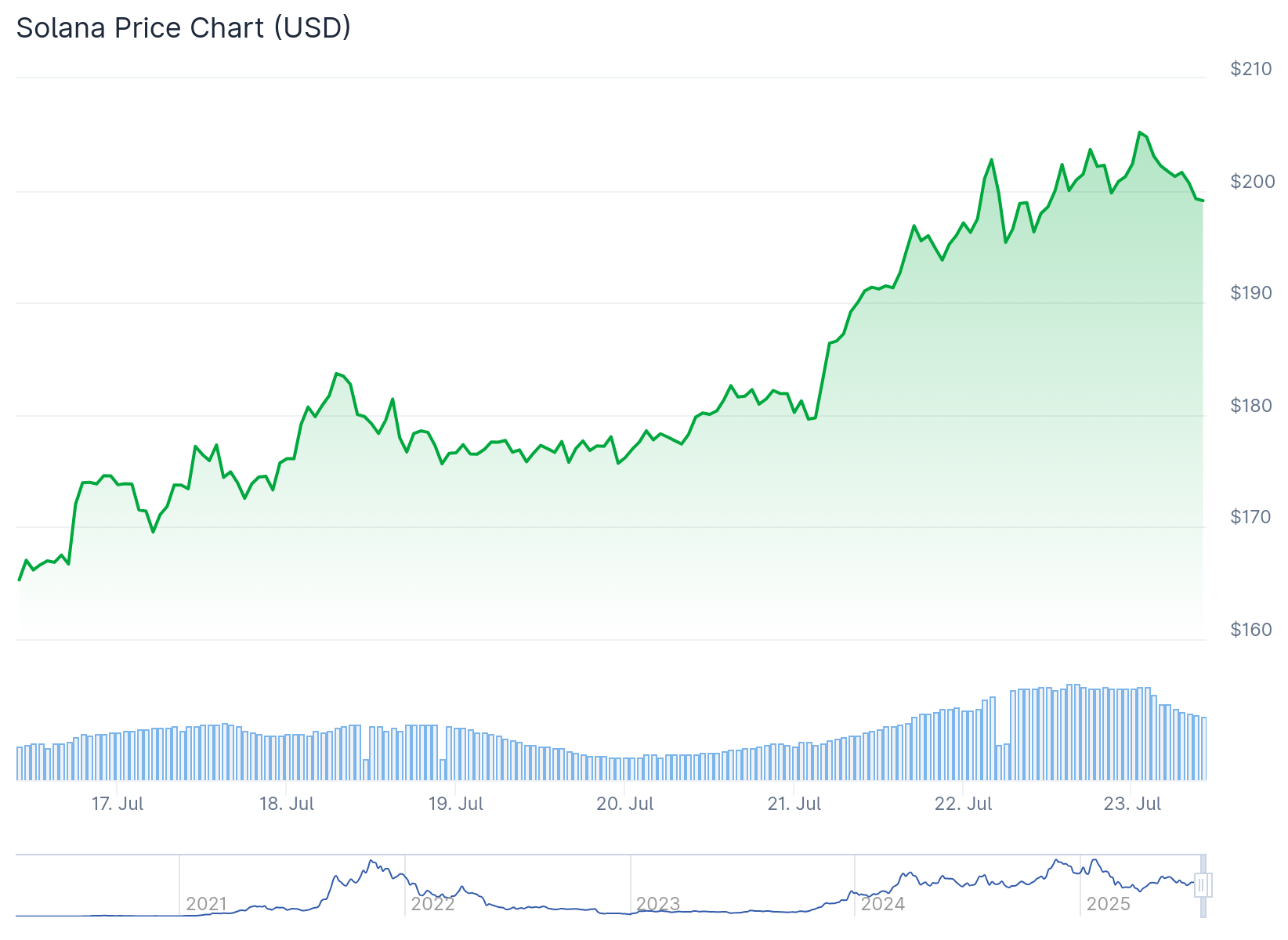Solana (SOL) Surges Toward ATH: Traders Brace for Historic Breakout as Momentum Builds
Solana's SOL isn't just rallying—it's gunning for the record books. The high-speed blockchain's native token has traders buzzing as it carves a path toward all-time highs, leaving sidelined FOMO investors scrambling.
Why the frenzy? Three words: institutional momentum meets retail euphoria. SOL's recent tear mirrors 2021's bull run patterns—except this time, the network actually works (most of the time).
Technical breakout or overleveraged bubble? Chartists point to clean resistance breaks while skeptics whisper about perpetual funding rates. Either way, crypto's favorite 'Ethereum killer' is putting on a clinic—just as Wall Street 'experts' finish their 'blockchain is useless' PowerPoint decks.
TLDR
- Solana price climbed above $200 for the first time in five months, reaching highs before settling around $197
- Market cap surpassed $105 billion, reclaiming levels not seen since January 2025
- Spot Solana ETF approval likelihood has soared to over 99% on prediction markets for 2025
- Staking liquidity increased with nearly $800 million in inflows, pushing TVL to $9.95 billion
- New wallet addresses spiked 26% with 1.5 million wallets created around the $195 level
Solana has broken through the $200 price barrier for the first time in five months. The cryptocurrency reached highs of $200 before settling around $197 in recent trading.

On July 21, SOL posted a strong 7.88% daily gain and closed at $195. This marked its highest daily close in nearly five months.
The rally unlocked $538 million in realized gains, representing a two-month peak. This suggests previously sidelined supply finally rotated out of positions.
Follow-through momentum remained measured in subsequent sessions. The next trading day saw SOL post a 4.61% intraday move.
Solana’s market capitalization recently surpassed $105 billion. This reclaimed levels not seen since January 2025 and overtook legacy firms like Intel in global rankings.
The price movement coincides with increased staking activity on the network. Off the back of a 23% weekly move, Solana’s total value locked saw sharp upticks.

Nearly $800 million in inflows pushed TVL to $9.95 billion. This marked the first time the network reclaimed this level in around 23 weeks.
ETF Approval Drives Institutional Interest
The likelihood of a spot solana ETF approval in 2025 has jumped to over 99% on prediction markets. Strong demand from major asset managers and SEC guidance on expedited applications fuel this optimism.
The REX-Osprey SOL and SOL Staking ETFs have already received automatic approval and begun trading. This signals a regulatory friendly approach toward Solana-based funds in the US.
The REX-Osprey SOL + Staking ETF now approaches $100 million in assets. The fund draws institutional attention due to its rare staking rewards structure.
Upexi, a Nasdaq-listed company, increased its Solana holdings by 100,000 SOL. This reflects growing corporate interest in the cryptocurrency.
DeFi Development Corp has accumulated 999,999 SOL tokens. The entity stakes and validates on the network, becoming a major on-chain player.
Technical Breakout Supports Rally
The price rally receives technical support from an inverse head-and-shoulders breakout above $159. This pattern targets new highs in the $185-$210 range.

A further breakout could push SOL to $220-$250 in the NEAR term. More ambitious targets reach $300 if the current trend continues.
Solana cleared a key supply zone at $185 during the rally. This level marked a major cost basis cluster for previous holders.
With previously underwater holders now profitable, the $538 million in realized gains could represent just the first wave of distribution.

New wallet creation spiked 26% around the $195 level. This brought 1.5 million fresh addresses into the ecosystem, signaling new demand at local highs.
Solana’s derivatives market open interest surged by $1.5 billion in three days. Futures trading volume on CME Group exceeded $4 billion, showing both institutional inflow and heightened speculation.
The gap between 30-day realized and implied volatility widened sharply. Implied volatility jumped from 4% to 14%, pointing to expectations of large future price movements.

